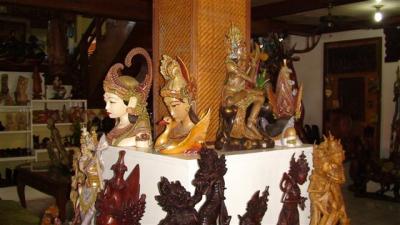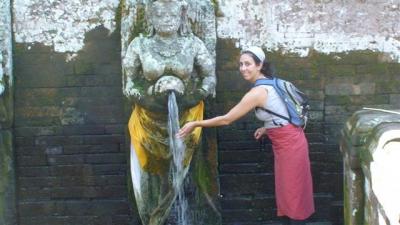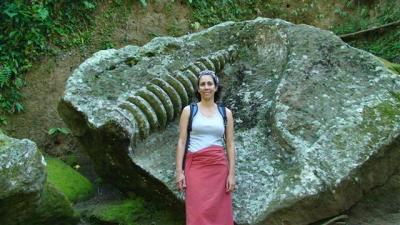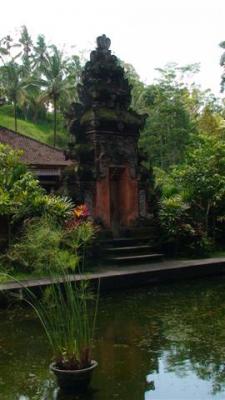Wayan picked us up at 0730 to continue our tour. We took a different route up to the mountains this time, but the scenery along the way was almost identical, with the narrow roads, neighborhoods of stores all selling the same product, and the Balinese style buildings with an occasional plot of land or forest peeking through.
Our first stop was at a wood carving shop called Manis The display area is enormous and the pieces are some of the most beautiful we have ever seen in our lives. We are talking award winning artistry here, the kind of work you pay hundreds of thousands for at home and brag about owning at cocktail parties. No exaggeration. It seriously looked more like an art museum than a shop. They offered goods ranging from small curio cabinet carvings, to statues and wall hangings, to furniture sets with matching couches, chairs, bar stools, tables and coffee tables. In the middle of the first floor display area there was a small team of people working away. You actually watched as a plain piece of wood took on a beautiful shape and marveled that the artist could see such a vision in a plain old piece of wood. There were people sanding and staining in addition to chiseling. The prices are outrageous by Indonesian standards, but a bargain by American standards.

While we looked around, we were followed by one of the staff who talked incessantly about each piece that we glanced at. At one point we passed a wall covered in reliefs. He explained to us what the scene depicted and told us the story the scene came from. All of them were from their culture, except one “The Last Supper”. When he got to that one, he simply said “I do not know the story for this one. A leader and his followers, I think”. We found it amusing that he didn’t know the story behind the one work we knew, and Christi gave him a tutorial on it. He said “Oh, so it is a tragedy story”.
When we were done looking at the display area, he took us on a tour of the grounds the building is on. The grounds not only house the shop, but the homes of the family members who own (and we think work in, but are not positive) the shop. We got a tutorial on Hindu beliefs, which shape every aspect of the Balinese culture, including the layout of homes and buildings. Each house has a small temple on the premises. It was actually quite interesting to find out what each of the rooms is used for and what each of the altars represents in the little home temples. He was quite eager to share the beliefs with us and proud of their complex culture and rich traditions. He answered a lot of questions we had about their gods, rituals and customs, such as “why do you go to a main temple when you have a home temple?” and “why do we see offerings absolutely everywhere?” We were surprised he took so much time to talk with us when we made it clear we weren’t buying anything, but it seemed to not matter to him whether we bought or not. It was more important to him that we have a richer tourist experience by better comprehending all we see around us.
The next stop was Goa Gajah (Elephant Cave), which is a Hindu temple built in the 11th century that was destroyed by a natural disaster. It was re-discovered in 1923 by a Dutch archeologist, and has since been restored. The Hindus now actively use this temple for worship. From the parking lot you have to walk down a long corridor of vendors in small stalls all pushing their wares on you. Many say over and over that you can’t get into the temple without a sarong and you needed to buy one from them. We beat our way to the ticket booth, where they gave us free loaner sarongs with the admission ticket. We walked down the long staircase to the courtyard area. At the landing, we were immediately approached by a local man who attached himself to us, following us around and giving us a recited speech explaining the history, symbolism, and meaning of everything we were seeing. We must stick out as suckers, because there were plenty of other people he could have attached himself to, but he made a beeline straight for us. He was actually quite informative, so we didn’t mind having him around.
As with most of the temples we have seen, there is a large pool of water in the courtyard. There were once seven statues of a female character against the back wall of this pool, each with water from a nearby stream coming out of her mouth, but one of the statues was too destroyed to be restored. It is believed that if you put the water on your face, it keeps you from aging, so of course, Christi splashed some on her face.

Off to the side of the pool, there is an altar with ancient stone carvings of the elephant God in it near the main temple entrance. The main temple is what makes this spot so special. Rather than a building, it is a cave. The entrance of the cave is a giant demon face, a spirit often depicted in the local artwork and on the buildings. You walk into the cave through the demon’s mouth. Inside the cave is T shaped, with several small alcoves dug out to the side of the main chamber where you can sit and mediate. There are a few bits and pieces left of the statues that once graced the interior, including a very phallic one that our guide talked about quite a bit.
From the level we were on, the temple grounds continued downward. We climbed down another staircase, enjoying the pretty setting of the terraced mountain forest that surrounds the temple grounds. We saw the remains of what was once another rock temple that slid off the hill and lay in pieces in a stream. The tour was done and the guide asked us for a donation, which we expected. We fought our way past the hawkers and jumped back in the car.

Stop three was yet another temple, Tirta Empul. It was built in 962 AD on natural water springs that are believed to have magical powers. We were a little templed out at this point, but much to our surprise, we had arrived in the midst of a big ceremony. After beating off a persistent banana salesman, we headed inside. The men mostly wore white or cream button down shirts or dress jackets with a double sarong skirt. The outer sarong was about calf length, then inner sarong to their ankles, and the fabrics were assorted colors and materials. Many men wore a headdress that looked like the bottom half of a turban, almost like someone just chopped of the top portion with a machete. The women mostly wore white long sleeved blouses with a brightly colored single sarongs to their ankles.
Large groups of people were on their knees bowing at the various altars. The altars were chock full of offerings, stacked up precariously high. The courtyard areas were full of people socializing. The pool was full of people who were purifying themselves in the magical, holy water. As non-Hindus, we couldn’t go into the main sanctuary, which also has springs in the center of it that run into the pool. It was actually pretty low key and mellow in a nice kind of way, not loud and obnoxious. The grounds, layout and decor were similar to all the other ones we had seen, but bigger and nicer. We are actually surprised at how well kept it is. It looks like it was built a few years ago, not over a thousand years ago!

To be continued”¦

Wow I thought everyone knew about the last supper.
You found the real fountain of youth, too bad you couldn’t fill a bottle of “water” and send it home to me!